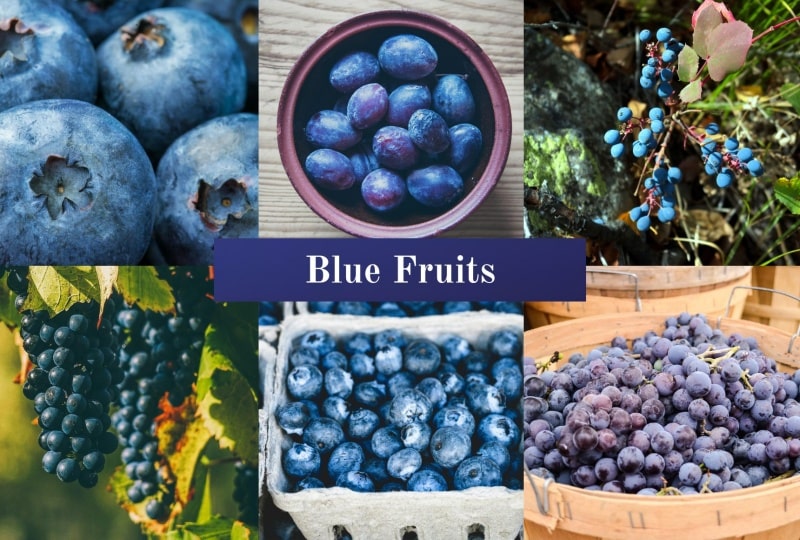In this article, we are going to some collections about blue fruits. So if you are very curious about them, you should stay with us and check out the list of blue fruits below. We hope you will like it and learn about the blue fruits. So please stay with us and attention the below blue fruits.
Every fruit has a different color: red, yellow, green, purple, blue, and many more. We all know that blue fruits are one of the most attractive fruits and people love to eat them. Some fruit’s outside is blue, some inside is blue and in some fruit both are blue.
People use blue fruits as salad, juice, jam, and smoothies. Incorporating a variety of blue fruits into your diet can add visual appeal to your meals and provide a range of benefits. Blue fruits have another type of taste and attractive look, that is impressive for people.
So, here we have discussed the topic of blue fruits, with their picture, vitamins, and benefits. So please stay with us and gain knowledge about the blue fruits.
Blueberry
Blueberry is the most common blue fruit, available is our outside. This is a small fruit, it has a delicious taste. People love it through blueberry juice, jam, shakes, salad, and as an afternoon snack. People also love to eat it by making it a smoothie. So next time you’re looking for a healthy and delicious snack, reach for a handful of blueberries and keep remembering our blog.
- Scientific Name:- Vaccinium sect. Cyanococcus.
- Vitamin Available:- Vitamin C & K.
- Benefits:- 1) Manage the blood pressure. 2) Regulate the blood sugar. 3) Maintain eye health.

Blue Corn
We all know that corn is a very healthy fruit, and it this very good for bone health. The intense blue hue of blue corn not only makes it aesthetically appealing but also sets it apart from traditional yellow or white corn. This is a fruit that is very attractive sense to the human. Blue corn is used to make different types of foods, tortilla chips, and many more.
- Scientific Name:- Zea mays.
- Vitamin Available:- Vitamin A, C & K.
- Benefits:- 1) Good for bones. 2) Help to increase muscle strength. 3) Improve eye health.
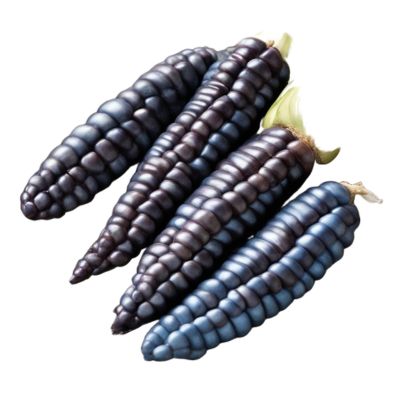
Concord Grape
Concord grape is one type of grape whose color is blue. This fruit is especially found in North America, people use this fruit as jam, jelly, juice, salad, and many more things. This fruit also looks like the normal fruit, but it is more attractive than the green grapes. Concord grapes are often recognized for their unique aroma and intense sweetness, setting them apart from other grape varieties.
- Scientific Name:- Vitis labrusca ‘Concord’.
- Vitamin Available:- Vitamin C.
- Benefits:- 1) Good for skin. 2) Maintain brain function. 3) Prevents Cancer.

Honeysuckle
Honeysuckle is a type of fruit, that has a different look, it is not round it looks like the elongated blueberry. Honeysuckle is a fragrant and delicate flowering plant known for its sweet-smelling blossoms and ornamental appeal. The color of a honeysuckle fruit is navy blue type.
- Scientific Name:- Lonicera caerulea.
- Vitamin Available:- Vitamin A, B & C.
- Benefits:- 1) Boost immunity. 2) Weight Management. 3) Relieving headaches.
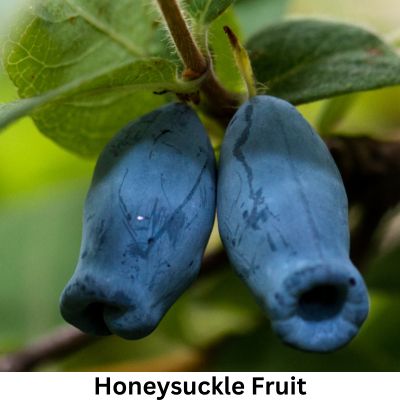
Bilberry
This is a tiny fruit that looks like a blueberry. This is a part of the berry fruits. Bilberries are often smaller and darker than blueberries, with a slightly tangy and sweet taste that sets them apart. This fruit can be eaten fresh and you can use it to make juice, jam, or sauces.
- Scientific Name:- Vaccinium myrtillus L.
- Vitamin Available:- Vitamin C.
- Benefits:- 1) Treat skin conditions. 2) May reduce inflammation. 3) Improves Vision.
Blue Java Banana
We especially know that bananas outside most of the time green or yellow. But the blue java banana’s outside is blue and it also totally looks attractive. Blue Java bananas, also known as Ice Cream bananas, are a unique and intriguing variety of bananas known for their light blue-green peels and creamy, vanilla-like flavor.
- Scientific Name:- Musa acuminata × balbisiana ‘Blue Java’.
- Vitamin Available:- Vitamin B6 & C.
- Benefits:- 1) Healthy digestion. 2) Protect cell damage. 3) Protect heart diseases.

Blue Olive
Blue olives are a type of Ceylon olive and a lesser-known species of olive tree native to Sri Lanka. The Ceylon olive tree is valued for its ornamental beauty, with its glossy dark green leaves and small, round fruits. It is a small round fruit, it is used for chutneys or the pickle. People love to taste that.
- Scientific Name:- Elaeocarpus serratus.
- Vitamin Available:- Vitamin E & K.
- Benefits:- Unknown.
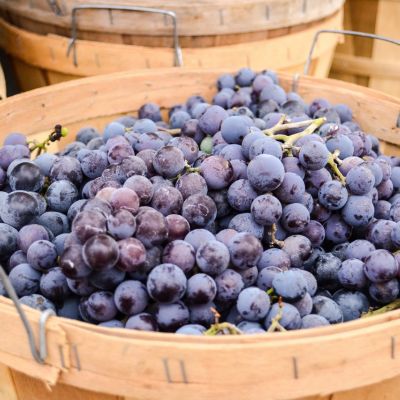
Filius Blue Pepper
Filius Blue Pepper This fruit is present in a delicious taste, and smell and is small in size also. The Filius Blue Pepper plant provides both visual interest and culinary excitement for those who appreciate unique and spicy varieties of peppers.
- Scientific Name:- Capsicum annuum.
- Vitamin Available:- Vitamin A & C.
- Benefits:- 1) Good for skin. 2) Promote red blood cells. 3) Maintain heart health.
Ribier Grapes
This fruit is also known as the ribier seedless grape. People love to eat it for their delicious taste. The grapes have a deep purple to almost black skin that encases juicy, flavorful pulp, offering a burst of sweetness with every bite. These fruits are mainly used in jam, juice, salad, and many more things.
- Scientific Name:- Vitis vinifera.
- Vitamin Available:- Vitamin C & K.
- Benefits:- 1) Cholesterol free. 2) Boost immunity system. 3) Reduce body fat.
Huckleberry
This is called a wild berry, so this berry is grown in a special mountain area and they are also specially known for their special taste. Huckleberries are small, round, and flavorful berries that are native to North America and closely related to blueberries. People can also enjoy it as fresh.
- Scientific Name:- Vaccinium.
- Vitamin Available:- Vitamin C & E.
- Benefits:- 1) Enhances brain function. 2) Supports Digestive Health. 3) Supports Heart Health.
Blue Jarrahdale Pumpkins
Blue Jarrahdale pumpkins are one type of pumpkin that’s the size pumpkin type. This fruit is a striking variety of winter squash known for its unique blue-gray skin and flavorful, dense flesh. This blue type of pumpkin offers a sweet flavor. That can make them a desirable ingredient in various dishes.
- Scientific Name:- Cucurbita maxima.
- Vitamin Available:- Vitamin A & D.
- Benefits:- 1) Maintain a healthy immunity system. 2) Supports for heart health. 3) Good for eye health.
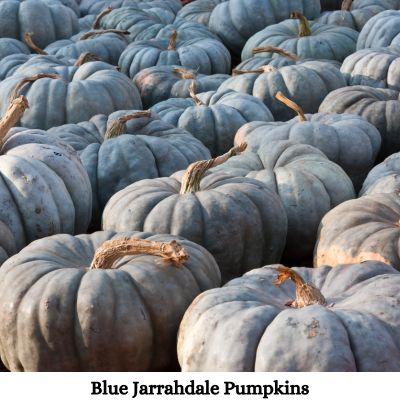
Blue Damson Plum
The blue damson plum is popular for its small size, valuable skin, and tart flavor. People love to use it and make jam, juice, and salad also. Whether this is transformed into a jam a rich dessert or a delicious sauce this fruit offers additional flavor to a variety of tastes.
- Scientific Name:- Prunus insititia.
- Vitamin Available:- Vitamin A, C & E.
- Benefits:- 1) Help for good sleep. 2) Weight management. 3) Good for heart health.
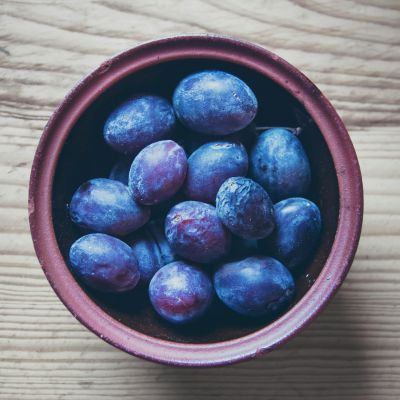
Saskatoon Berries
These Saskatoon berries are also known as the serviceberries and juneberries. This small fruit has a distinguishing feature of Saskatoon berries in its versatile flavor profile, combining notes of sweetness with a hint. Their unique taste nutritional value and cultural dispute make them popular.
- Scientific Name:- Amelanchier alnifolia.
- Vitamin Available:- Vitamin C, E & K.
- Benefits:- 1) Reduce fat. 2) Support immunity system. 3) Help for bone strength.
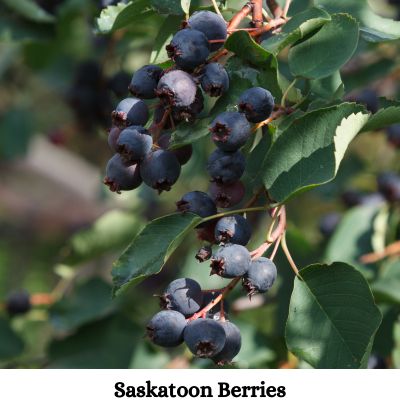
Prunus Spinosas
This fruit is also called the blackthorn or sole. This fruit is found in West Asia, Europe, and some parts of North America. This fruit is small but they have a delicious taste. Sole is a well-known beverage enjoyed for its rich, fruity taste and deep red color. Sloe jams, jellies, and syrups are also the best ways to enjoy the unique flavor of sloe or prunus spinosas.
- Scientific Name:- Blackthorn plum.
- Vitamin Available:- Vitamin A, B, C, & K.
- Benefits:- 1) Good for skin health. 2) Support bone health. 3) Boost immunity system.

Blue Grapes
The blue grapes size is the same as the common grapes. People love to enjoy it as fresh or jam, jelly or juice. They are very rich in nutritional value and deep attractive color. This fruit provides a satisfying flavor and some delicious that can make a perfect wide range of a plate or dishes.
- Scientific Name:- Vitis vinifera.
- Vitamin Available:- Vitamin C, B2 & K.
- Benefits:- 1) Protect against cancer. 2) Good for eye problems. 3) Reduce fat.
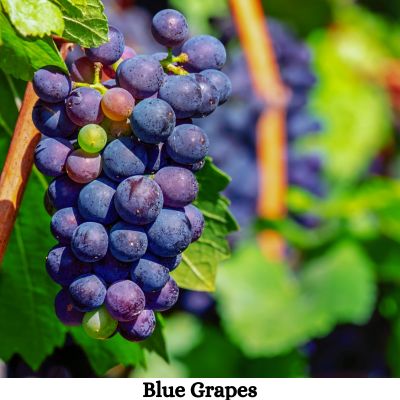
FAQ ( Frequently Asked Questions )
What are the most common blue fruits?
Ans:- These are the most common Blueberry, blue apple, and blue grapes.
Why some fruits are blue?
Ans:- In this world, many fruits are blue, because of their nutritional value, attracting pollinators, protection, and attractiveness.
What are the common benefits of blue fruits?
Ans:- These are some common benefits of skin health, eye health, brain health, and boost immunity support. All the blue fruits has this type of benefit.
Read More:-
Wrapping Up
We feel relaxed after sharing the information with you about the blue fruits. We hope you have liked them and know about them. So please share it on your social media platform to learn about this from others. This is also good information for the kids and upper students.

